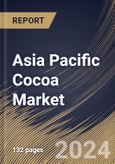Cocoa is increasingly used in savoury dishes, marinades, and sauces, contributing depth and complexity to diverse cuisines. The adoption of this in culinary fusion reflects exploring new and creative ways to integrate this versatile ingredient into various culinary traditions. Consumers are showing a heightened interest in artisanal and craft chocolate products. This trend reflects a desire for unique flavour experiences, higher content, and an appreciation for the craftsmanship involved in small-batch chocolate production.
Premiumization extends to gourmet chocolate offerings, with consumers willing to pay a premium for high-quality cocoa and unique flavour profiles. Chocolatiers are experimenting with exotic ingredients and innovative techniques to create distinctive, luxury chocolates. Dark chocolate is becoming increasingly popular on account of the perception that it offers health benefits, owing to its higher content. Consumers are drawn to dark chocolate for its antioxidant properties and potential mood-enhancing effects, aligning with a broader focus on health and wellness.
Pharmaceutical companies are exploring using extracts to develop nutraceutical products that provide health benefits beyond basic nutrition in the Asia Pacific. The pharmaceutical industry’s endorsement of it’s health benefits can increase consumer awareness and acceptance in the Asia Pacific. Consumers may be more inclined to incorporate these products into their daily routines for their perceived health advantages in the Asia Pacific. With an aging population in Asia Pacific, there is interest in addressing cognitive disorders. Therefore, due to the above-mentioned factors, the market will grow significantly in this region.
The China market dominated the Asia Pacific Cocoa Market, by Country in 2022, and would continue to be a dominant market till 2030; thereby, achieving a market value of $2858.9 Million by 2030. The Japan market is registering a CAGR of 4.6% during (2023 - 2030). Additionally, The India market would showcase a CAGR of 6% during (2023 - 2030).
Based on Application, the market is segmented into Confectionery, Food & Beverages, Cosmetics, and Pharmaceutical. Based on Product Type, the market is segmented into Cocoa Beans, Cocoa Powder & Cake, Cocoa Butter, Chocolate, and Others. Based on countries, the market is segmented into China, Japan, India, South Korea, Australia, Malaysia, and Rest of Asia Pacific.
List of Key Companies Profiled
- The Barry Callebaut Group
- JB Foods Limited
- Archer Daniels Midland Company
- Cargill, Incorporated
- Ciranda, Inc.
- Nestle S.A
- Mars, Inc. (Kind LLC)
- Meiji Holdings Co., Ltd.
- Olam International Limited
- The Hershey Company (Hershey Trust Company)
Market Report Segmentation
By Application (Volume, Kilo Tonnes, USD Billion, 2019-2030)- Confectionery
- Food & Beverages
- Cosmetics
- Pharmaceutical
- Cocoa Beans
- Cocoa Powder & Cake
- Cocoa Butter
- Chocolate
- Others
- China
- Japan
- India
- South Korea
- Australia
- Malaysia
- Rest of Asia Pacific
Table of Contents
Companies Mentioned
- The Barry Callebaut Group
- JB Foods Limited
- Archer Daniels Midland Company
- Cargill, Incorporated
- Ciranda, Inc.
- Nestle S.A
- Mars, Inc.(Kind LLC)
- Meiji Holdings Co., Ltd.
- Olam International Limited
- The Hershey Company (Hershey Trust Company)








